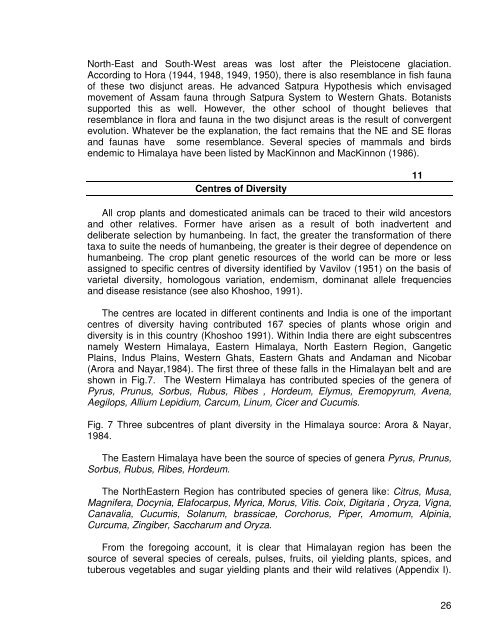Pandit Govind Ballabh Pant Memorial Lecture: II
Pandit Govind Ballabh Pant Memorial Lecture: II
Pandit Govind Ballabh Pant Memorial Lecture: II
You also want an ePaper? Increase the reach of your titles
YUMPU automatically turns print PDFs into web optimized ePapers that Google loves.
North-East and South-West areas was lost after the Pleistocene glaciation.<br />
According to Hora (1944, 1948, 1949, 1950), there is also resemblance in fish fauna<br />
of these two disjunct areas. He advanced Satpura Hypothesis which envisaged<br />
movement of Assam fauna through Satpura System to Western Ghats. Botanists<br />
supported this as well. However, the other school of thought believes that<br />
resemblance in flora and fauna in the two disjunct areas is the result of convergent<br />
evolution. Whatever be the explanation, the fact remains that the NE and SE floras<br />
and faunas have some resemblance. Several species of mammals and birds<br />
endemic to Himalaya have been listed by MacKinnon and MacKinnon (1986).<br />
Centres of Diversity<br />
11<br />
All crop plants and domesticated animals can be traced to their wild ancestors<br />
and other relatives. Former have arisen as a result of both inadvertent and<br />
deliberate selection by humanbeing. In fact, the greater the transformation of there<br />
taxa to suite the needs of humanbeing, the greater is their degree of dependence on<br />
humanbeing. The crop plant genetic resources of the world can be more or less<br />
assigned to specific centres of diversity identified by Vavilov (1951) on the basis of<br />
varietal diversity, homologous variation, endemism, dominanat allele frequencies<br />
and disease resistance (see also Khoshoo, 1991).<br />
The centres are located in different continents and India is one of the important<br />
centres of diversity having contributed 167 species of plants whose origin and<br />
diversity is in this country (Khoshoo 1991). Within India there are eight subscentres<br />
namely Western Himalaya, Eastern Himalaya, North Eastern Region, Gangetic<br />
Plains, Indus Plains, Western Ghats, Eastern Ghats and Andaman and Nicobar<br />
(Arora and Nayar,1984). The first three of these falls in the Himalayan belt and are<br />
shown in Fig.7. The Western Himalaya has contributed species of the genera of<br />
Pyrus, Prunus, Sorbus, Rubus, Ribes , Hordeum, Elymus, Eremopyrum, Avena,<br />
Aegilops, Allium Lepidium, Carcum, Linum, Cicer and Cucumis.<br />
Fig. 7 Three subcentres of plant diversity in the Himalaya source: Arora & Nayar,<br />
1984.<br />
The Eastern Himalaya have been the source of species of genera Pyrus, Prunus,<br />
Sorbus, Rubus, Ribes, Hordeum.<br />
The NorthEastern Region has contributed species of genera like: Citrus, Musa,<br />
Magnifera, Docynia, Elafocarpus, Myrica, Morus, Vitis. Coix, Digitaria , Oryza, Vigna,<br />
Canavalia, Cucumis, Solanum, brassicae, Corchorus, Piper, Amomum, Alpinia,<br />
Curcuma, Zingiber, Saccharum and Oryza.<br />
From the foregoing account, it is clear that Himalayan region has been the<br />
source of several species of cereals, pulses, fruits, oil yielding plants, spices, and<br />
tuberous vegetables and sugar yielding plants and their wild relatives (Appendix I).<br />
26











